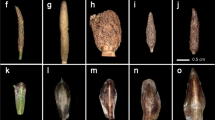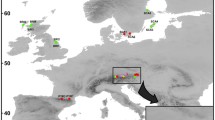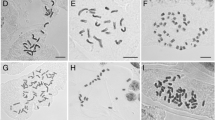Abstract
Taxa endemic to North-western Europe are rare, but the orchid genusDactylorhiza contains several species restricted to this area. Evidence from morphological and cytological studies have indicated that some species may have arisen recently and may be of hybrid origin. In the present report, I use allozymes to characterize the genomes in various species ofDactylorhiza and evaluate the possibilities for rapid evolutionary change in the genus. Allotetraploid species have evolved repeatedly from two principal diploid ancestral lineages. These lineages include extant diploid and autotetraploid species, from which allotetraploid derivatives may still arise. It is suggested that allotetraploidization dominates over introgression as speciation mechanism in the genus. The more common and widespread allotetraploid species could be characterized by their allozyme characters over considerable distances, indicating that each of them may have a unique origin and that they have spread from their ancestral populations to the present distribution areas. However, it is also possible that some allotetraploid species contain local populations that have been independently derived from the ancestral lineages.
Similar content being viewed by others
References
Ashton, G. C., Braden, A. W. H., 1964: Serum ß-globulin polymorphism in mice. — Austral. J. Biol. Sci.14: 248–254.
Bateman, R. M., Denholm, I., 1983: A reappraisal of the British and Irish dactylorchids, 1. The tetraploid marsh-orchids. — Watsonia14: 347–376.
—, —, 1988: A reappraisal of the British and Irish dactylorchids, 3. The spotted-orchids. — Watsonia17: 319–349.
Borgen, L., 1987: Postglacial evolution in the Nordic flora — a review. — Blyttia45: 147–169.
Briggs, D., Walters, S. M., 1984: Plant variation and evolution. — Cambridge: Cambridge University Press.
Clausen, J., Keck, D. D., Hiesey, W. M., 1945: Experimental studies on the nature of species. II. Plant evolution through amphiploidy and autoploidy, with examples from theMadiinae. — Carnegie Inst. Wash. Publ.564: 1–174.
Corrias, B., Rossi, W., Arduino, P., Cianchi, R., Bullini, L., 1991:Orchis longicornu Poiret in Sardinia: genetic, morphological and chorological data. — Webbia45: 71–101.
Cox, C. B., Healey, I. N., Moore, P. D., 1976: Biogeography. — Oxford: Blackwell.
Crawford, D.J., 1989: Enzyme electrophoresis and plant systematics. — InSoltis, D.E., Soltis, P. S., (Eds): Isozymes in plant biology, pp. 146–164. — Portland, Oregon: Dioscorides.
DeWet, J. M. J., 1980: Origins of polyploids. — InLewis, W.H., (Ed.): Polyploidy. Biological relevance, pp. 3–15. — New York: Plenum Press.
Ehrendorfer, F., 1980: Polyploidy and distribution. — InLewis, W.H., (Ed.): Polyploidy. Biological relevance, pp. 45–60. — New York: Plenum Press.
Gathoye, J.-L., Tyteca, D., 1994: Clé et inventaire synonymique desDactylorhiza (Orchidaceae) de France et du Benelux. — Lejeunia143: 1–85.
Grant, V., 1981: Plant speciation. — New York: Columbia University Press.
Hagerup, O., 1938: Studies on the significance of polyploidy. II.Orchis. — Hereditas24: 258–264.
Heslop-Harrison, J., 1953a: Studies inOrchis L. II.Orchis traunsteineri Saut. in the British Isles. — Watsonia2: 371–391.
—, 1953b: Microsporogenesis in some triploid dactylorchid hybrids. — Ann. Bot. (London)17: 539–549.
—, 1954: A synopsis of the dactylorchids of the British Isles. — Ber. Geobot. Forschungsinst. Rübel Zürich1953: 53–82.
Holmen, K., Kaad, P., 1956: ÜberDactylorchis traunsteineri auf der Insel Läsö. — Bot. Tidsskr.53: 35–48.
Höppner, H., 1927: ×Orchis Beckerianus H. Höppner und sein Formenkreis nebst Bemerkungen zu verwandten Formenkreisen. — Sitzungsber. Naturhist. Vereins Preuss. Rheinl.1926: 1–26.
Hylander, N., 1966: Nordisk kärlväxtflora II. — Stockholm: Almquist & Wiksell.
Jackson, R. C., Casey, J., 1980: Cytogenetics of polyploids. — InLewis, W. H., (Ed.): Polyploidy. Biological relevance, pp. 17–44. — New York: Plenum Press.
Jenkinson, M. N., 1991: The Marsh Orchids in Hampshire and Dorset: Some recent research. — Proc. Hampsh. Field Club Archaeol. Soc.47: 225–252.
Jonsell, B., 1982:Dactylorhiza incarnata andD. traunsteineri in northernmost Uppland, Central Sweden. — Svensk Bot. Tidskr.76: 103–111.
King, J. N., Danzik, B. P., 1983: Inheritance and linkage of isozymes in white spruce (Picea glauca). — Canad. J. Genet. Cytol.25: 430–436.
Krok, T. O. B. N., Almquist, S., 1984: Svensk Flora (26th edn.). — Uppsala: Esselte.
Lagercrantz, U., Ryman, N., 1990: Genetic structure of Norway spruce (Picea abies): concordance of morphological and allozyme variation. — Evolution44: 38–53.
Lewis, W. H., 1980: Polyploidy in species populations. — InLewis, W. H., (Ed.): Polyploidy. Biological relevance, pp. 103–144. — New York: Plenum Press.
Lid, J., 1986: Norsk, svensk, finsk flora. — Oslo: Det norske samlaget.
Lord, R. M., Richards, A. J., 1977: A hybrid swarm between the diploidDactylorhiza fuchsii (Druce)Soó and the tetraploidD. purpurella (T. & T. A. Steph.)Soó in Durham. — Watsonia11: 205–210.
Lönn, M., Prentice, H. C., 1990: Mosaic variation in SwedishPetrorhagia prolifera (Caryophyllaceae): the partitioning of morphometric and electrophoretic diversity. — Biol. J. Linn. Soc.41: 353–373.
Maceira, N. O., De Haan, A. A., Lumaret, R., Billon, M., Delay, J., 1992: Production of 2n gametes in diploid subspecies ofDactylis glomerata L. 1. Occurrence and frequency of 2n pollen. — Ann. Bot. (London)69: 335–343.
Malmgren, S., 1992: Crossing and cultivation experiments with Swedish orchids. — Svensk Bot. Tidskr.86: 337–346.
Mossberg, B., Stenberg, L., Ericsson, S., 1992: Den nordiska floran. — Stockholm: Wahlström & Widstrand.
Nelson, E., 1976: Monographie und Ikonographie der Orchidaceen-GattungDactylorhiza. — Zürich: Speich.
Nordal, I., 1987: Tabula rasa after all? Botanical evidence for ice-free refugia in Scandinavia reviewed. — J. Biogeogr.14: 377–388.
Pettersson, B., 1947: On some hybrid populations ofOrchis incarnata ×maculata in Gotland. — Svensk Bot. Tidskr.41: 115–141.
Roberts, R. H., 1966: Studies on Welsh orchids. III. The coexistence of some of the tetraploid species of marsh orchids. — Watsonia6: 260–267.
—, 1975:Dactylorhiza. — InStace, C. A., (Ed.): Hybridization and the flora of the British Isles, pp. 495–506. — London: Academic Press.
Roose, M. L., Gottlieb, L. D., 1976: Genetic and biochemical consequences of polyploidy inTragopogon. — Evolution30: 818–830.
Rossi, W., Corrias, B., Arduino, P., Cianchi, R., Bullini, L., 1992: Gene variation and gene flow inOrchis morio (Orchidaceae) from Italy. — Pl. Syst. Evol.179: 43–58.
SAS Institute, 1990: SAS/STAT User's guide. — Cary, NC: SAS Institute.
Scacchi, R., De Angelis, G., 1989: Isoenzyme polymorphisms inGymnadenia conopsea and its inferences for systematics within this species. — Biochem. Syst. Ecol.17: 25–33.
—, 1987: Study of electrophoretic variability inEpipactis helleborine (L.)Cranz,E. palustris (L.)Cranz andE. microphylla (Ehrh.)Swartz (fam.Orchidaceae). — Genetica72: 217–224.
—, 1990: Allozyme variation among and within elevenOrchis species (fam.Orchidaceae), with special reference to hybridizing aptitude. — Genetica81: 143–150.
Schlegel, M., Steinbrück, G., Hahn, K., Röttger, B., 1989: Interspecific relationship of ten Europaean orchid species as revealed by enzyme electrophoresis. — Pl. Syst. Evol.163: 107–119.
Sneath, P. H. A., Sokal, R. R., 1973: Numerical taxonomy. — San Francisco: Freeman.
Soltis, D. E., Rieseberg, L. H., 1986: Autopolyploidy inTolmiea menziesii (Saxifragaceae): Genetic insights from enzyme electrophoresis. — Amer. J. Bot.73: 310–318.
—, 1993: Molecular data and the dynamic nature of polyploidy. — CRC Crit. Rev. Pl. Sci.12: 243–273.
—, 1983: Starch gel electrophoresis of ferns: A compilation of grinding buffers, gel and electrode buffers, and staining schedules. — Amer. Fern J.73: 9–27.
Soó, R. De, 1980:Dactylorhiza. — InTutin, T. G., Heywood, V. H., Burges, N. A., Moore, D. M., Valentine, D. H., Walters, S. M., Webb, D. A., (Eds): Flora Europea,5, pp. 333–337. — Cambridge: Cambridge University Press.
Stebbins, G. L., 1980: Polyploidy in plants: Unsolved problems and prospects. — InLewis, W.H., (Ed.): Polyploidy. Biological relevance, pp. 495–520. — New York: Plenum Press.
Steinbrück, G., Schlegel, M., Dahlström, I., Röttger, B., 1986: Characterization of interspecific hybrids betweenOrchis mascula andO. pallens (Orchidaceae) by enzyme electrophoresis. — Pl. Syst. Evol.153: 229–241.
Vermeulen, P., 1938: Chromosomes inOrchis. — Chron. Bot.4: 107–108.
Weeden, N. F., Wendel, J. F., 1989: Genetics of plant isozymes. — InSoltis, D.E., Soltis, P. S., (Eds): Isozymes in plant biology, pp. 46–72. — Portland, Oregon: Dioscorides Press.
Wendel, J. F., Weeden, N.F., 1989: Visualization and interpretation of plant isozymes. — InSoltis, D. E., Soltis, P. S., (Eds): Isozymes in plant biology, pp. 5–45. — Portland, Oregon: Dioscorides Press.
Werth, C. R., Guttman, S. I., Eshbaugh, W. H., 1985: Electrophoretic evidence of reticulate evolution in the AppalachianAsplenium complex. — Syst. Bot.10: 184–192.
Author information
Authors and Affiliations
Rights and permissions
About this article
Cite this article
Hedrén, M. Genetic differentiation, polyploidization and hybridization in northern EuropeanDactylorhiza (Orchidaceae): Evidence from allozyme markers. Pl Syst Evol 201, 31–55 (1996). https://doi.org/10.1007/BF00989050
Received:
Revised:
Accepted:
Issue Date:
DOI: https://doi.org/10.1007/BF00989050




